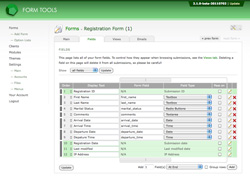Fields tab
Form Management
The fields tab lists all of your form fields and their main settings. This page has radically changed since the 2.0.x releases. Now, the Fields tab contains all the settings that used to be found on the Edit Form -> Database tab, as well as lets you customize all the custom field type-specific settings (like the data source for multi-select field types) through a dialog window. Having all the information available in a single page makes this new page substantially faster to configure than previous versions, however, we do admit that it can be a little intimidating for newbies!
The Fields table
The page lists all fields in a table. For slow servers, or forms with a huge number of fields, there's an option at the top to show a subset of the total number of fields.
The table itself has scrollbars at the top and bottom over a number of the columns. That area is scrollable. Try scrolling the section to see the additional fields. By default, you can see the Form Field, Field Type and Pass On columns (as seen in the screenshot above) but after you scroll to the right, you can also see Field Size, Sort As and DB Column columns.
The scrolling adds complexity to the page, but it also provides you with a very fast way to update certain key values in multiple fields at once.
The table can be resorted and grouped using the first column. For more information on that functionality, see the Sortables and Groupables page.
Lastly, the edit icon opens a dialog window containing all settings for the field type. For more information on that, see the section on the Edit Field Dialog, as well as the pages about each individual Field Type. The contents of the second tab in the dialog changes depending on the Field Type selected.
The Columns
Here's a description of what each of the columns mean on the page.
OrderDisplay TextForm FieldField TypePass On